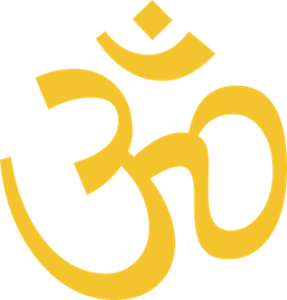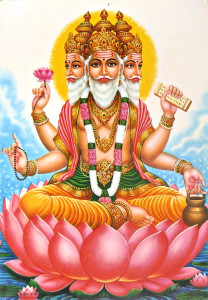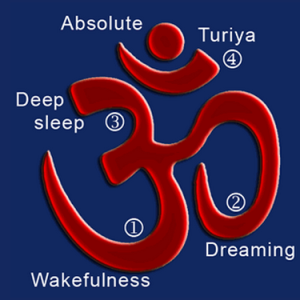 OM. That is the western spelling of the sanskrit symbol you see to the left. The proper phonetic pronunciation is actually more like AUM than OM and while it still seems fairly exotic, it is becoming widely recognized in western culture. But what does it mean?
OM. That is the western spelling of the sanskrit symbol you see to the left. The proper phonetic pronunciation is actually more like AUM than OM and while it still seems fairly exotic, it is becoming widely recognized in western culture. But what does it mean?
Generally people have some awareness that it has some spiritual meaning that is used in the east the way we use ‘amen’ in the west. We might have heard that it is the “sound of the universe” or “it represents the timeless oneness” or something equally vague, but if you are like me, those kinds of answers just don’t cut it. I want the juicy stuff!
The truth is that, Om is a cultural symbol so rich and full of meaning, a syllable that carries so much weight, that it is hard to sum up it’s meaning in a convenient sound bite. Nonetheless there are real answers, and I will attempt to offer you a real and more complete answer here.
Our answers begin in the Mandukya Upanishad, an ancient yoga text written 800-500 years before Christ. Within it we find explanations of both the concepts behind the sound and the shape of the symbol itself.
The first paragraph of the Mandukya tells us:
“The syllable OM, which is the imperishable Brahman, is the universe. Whatsoever has existed, whatsoever exists, and whatsoever shall exist hereafter, is OM. And whatsoever transcends past, present, and future, that also is OM.”
 Brahman is the name for the Hindu concept of ultimate divinity – the essence of reality existing in and as all things. If you are unfamiliar or uncomfortable with the label “Brahman” it can be replaced with whatever label you associate with the highest reality. It can be God, Jesus, Buddha, Mother Nature or any other label that you can comfortably refer to as the divine.
Brahman is the name for the Hindu concept of ultimate divinity – the essence of reality existing in and as all things. If you are unfamiliar or uncomfortable with the label “Brahman” it can be replaced with whatever label you associate with the highest reality. It can be God, Jesus, Buddha, Mother Nature or any other label that you can comfortably refer to as the divine.
The Om sound represents this higher power and its connection to each of us.
Further reading in the Mandukya helps to clarify:
“All this that we see without is Brahman. This Self that is within is Brahman. This Self, which is one with OM, has three aspects, and beyond these three, different from them and indefinable – The Fourth.”
Did I say “clarify”?
Ok, lets take that piece by piece. “All this that we see without is Brahman” means that everything that surrounds us in the physical world is an expression of the divine.
“This Self that it within is Brahman” tells us that we are not the exception to the rule, we are also an expression of the divine.
So far that is straightforward enough but then we get hit with, “This Self, which is one with OM, has three aspects, and beyond these three, different from them and indefinable – The Fourth.”
OM: A Symbol of Divinity
The Om sound represents and affirms our connection to the highest form of divinity by whatever name, because it serves to remind us that this very same divinity resides all around us, within us and even as us, though we may not know or understand it.
 However, Om also represents different states of human consciousness. The Mandukya mentions three aspects of the self or states of consciousness – plus the indescribable Fourth.
However, Om also represents different states of human consciousness. The Mandukya mentions three aspects of the self or states of consciousness – plus the indescribable Fourth.
The first state of consciousness is known as Vaishvanara. Despite the name which sounds quite exotic to western ears, this is a state of consciousness that we are all very familiar with. Vaishvanara is simply your normal waking state which is focused outward and intent upon the world around you. In the symbol, the waking state is represented by the lower curve of the “3”. This state is also represented in the sound (remember the phonetic A-U-M). Vaishvanara is the state is represented by the A sound, “Ah”.
The second state of consciousness is called Taijasa. This is another common state that we are generally familiar with. Taijasa is the state which is focused inward and in which we dream. This state witnesses the endless stream of thoughts, mental images and emotions. Taijasa, the dreaming state is represented by the curl that loops out from the back of the “3.” and the sound that represents Taijasa is the U sound.
The third state of consciousness, called Prajna, is the state of deep dreamless sleep or deep formless meditation. As stated in the Mandukya, “…the veil of unconsciousness envelopes his thought and knowledge, and the subtle impressions of his mind apparently vanish.” The dreamless state, Prajna, is represented by the top curve of the “3” and by the M sound.
The indescribable Fourth state is called Turiya, and as implied it is not easy to describe. Some would say this is the non-dual state and there are many attempts at labeling this but it must be noted that no label or description is really accurate. With that in mind I shall use the words of the great Non-Dual Sage Bhagavan Sri Ramana Maharshi:
 “. . .That Awareness which alone remains – that I am.”
“. . .That Awareness which alone remains – that I am.”
The Fourth state is represented by the crescent and dot in the upper right, but the sound of Turiya is actually the silence after the AUM. These four states of consciousness are the composite of human nature. They exist in all of us at all times.
So as you can see the Om symbol and sound are packed with meaning that simply can’t be reduced to a concise description. Saying that it is the sound of the universe may be a little easier, but understanding the powerful philosophy and culture that the symbol comes from is more helpful to growth and development.
When understood properly, Om becomes a reminder of the omnipotence and omnipresence of Divinity as well as a reminder of our own place within and connection to that Divinity.
OM~
Michael Sunspirit

